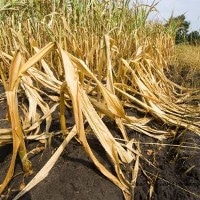Dec 10 2019
Severe climatic conditions could elevate the risk of abnormally low agricultural harvests, if more than one global breadbasket is influenced by drastic climate conditions simultaneously.
 Image Credit: © Buurserstraat386 / Dreamstime.
Image Credit: © Buurserstraat386 / Dreamstime.
The results of a recent study at IIASA demonstrate that these breadbaskets, which are the geographical areas where growing a major portion of the world’s food is grown, are at risk to produce sufficient soybean, maize, and wheat due to severe temperatures.
Climate change not only leads to a constant increase in temperatures, but also results in a higher frequency and intensity of drastic climatic events, such as floods, droughts, and heatwaves. These severe conditions are specifically harmful to agriculture.
The climatic changes cause at least 30% of the yearly fluctuations in agricultural yield across the world. The global food system, under “normal” climatic conditions, can make up for local crop losses through trade and grain storage. However, it is uncertain whether the existing system is resistant to more severe climatic conditions.
In a research work reported in the journal Nature Climate Change, scientist Franziska Gaupp from IIASA and her colleagues analyzed the risk of breadbasket failures due to climatic extremes at the same time, and in what way the risk has varied over time.
Climatic connections between global phenomena such as the El Niño Southern Oscillation (ENSO) and regional climate extremes such as Indian heatwaves, or flood risks around the globe pose a risk to the global food system.
Franziska Gaupp, Study Lead Author, IIASA
Gaupp added, “Climatic shocks to agricultural production contribute to food price spikes and famine, with the potential to trigger other systemic risks, including political unrest and migration. This analysis can provide the basis for a more efficient allocation of resources to contingency plans and strategic crop reserves that would enhance the resilience of the global food system.”
The research work analyzes crop yield and climatic information for the major agricultural regions within the highest crop yielding countries by mass, for the period of 1967 to 2012. The study reveals that there has been a considerable increase in the possibility of several worldwide breadbasket failures, specifically for soybeans, wheat, and maize.
For instance, in the case of soybeans, the impact of crop failure in all main breadbaskets related to climate risk would be at least 12.55 million tons of crop losses. This is more than the 7.2 million tons of losses that occurred in 1988–1989. This is one of the largest historical soybean production shocks.
On a global level, there is both positive and negative association between climatic dependence and the world’s breadbaskets. There is a negative association between the risks based on precipitation for soybean breadbaskets in Argentina and India.
This implies that heavy rainfall in India will influence the local soybean harvest negatively, but this can be dealt with by imports from Argentina. Thus, it is possible to balance out crop losses.
By contrast, there is a positive association between the maximum temperature in Australia and the EU, for instance. The risk of elevated temperatures in Australia caused by climate change could have an impact on the amount of wheat exported to the EU. Furthermore, this could result in extra pressure on the EU when there is drought during the wheat season.
This study is the first of this scale and type. Although the chances of a climatic extreme affecting more than one worldwide breadbasket have been a growing cause for worry, only a few research works have analyzed the probability of production shocks occurring at the same time.
Our approach is able to estimate simultaneous large-scale extreme climatic events in a risk-based manner, and therefore enables the development of new risk response strategies.
Stefan Hochrainer-Stigler, Study Coauthor, IIASA
Hochrainer-Stigler is a researcher with the Risk and Resilience Program at IIASA.